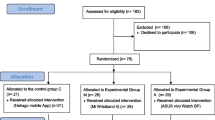Toward a persuasive mobile application to reduce sedentary behavior

Prolonged sitting is a potential health risk, not only for people with an inactive lifestyle but also for those who meet the daily physical activity recommendations. Mobile applications that trigger people to take regular breaks from sitting seem promising. In this paper, we present the results of our quest to create effective persuasive mobile applications aimed at reducing sedentary behavior. First, we developed SitCoach, a mobile application to nudge office workers from their seats. SitCoach monitors physical activity and sedentary behavior and provides timely persuasive messages suggesting active breaks. A user test showed that users had little awareness of the risks of prolonged sitting and considered their ability to take active breaks to be highly dependent on external factors. The results from this study formed the basis for a second experiment, which was more extensive in duration and number of participants. In this 6-week experiment, office workers received timely persuasive messages on their smart phones, advising them to take an active break whenever they were sitting behind their computer for too long. Compared to a Control group who did not receive these messages, a significant decrease in computer activity was achieved. The studies show the potential and limitations of using a smart phone as a platform for reducing sedentary behavior. We conclude with recommendations to create effective mobile applications that motivate people to take regular breaks from sitting.
This is a preview of subscription content, log in via an institution to check access.
Access this article
Subscribe and save
Springer+ Basic
€32.70 /Month
- Get 10 units per month
- Download Article/Chapter or eBook
- 1 Unit = 1 Article or 1 Chapter
- Cancel anytime
Buy Now
Price includes VAT (France)
Instant access to the full article PDF.
Rent this article via DeepDyve

Similar content being viewed by others

Preliminary Investigation on Malaysian Office Workers’ Sedentary Behaviour, Health Consequences, and Intervention Preferences: Towards Designing Anti Sedentary Behaviour Change Support Systems
Chapter © 2022

Smart Wearable Device Users’ Behavior Is Essential for Physical Activity Improvement
Article 06 August 2021

The Awareness of Human’s Sedentary Behavior in the Workplace and Product Design Guidelines
Chapter © 2017
References
- Bankoski A, Harris TB, McClain JJ, Brychta RJ, Caserotti P, Chen KY, Berrigan D, Troiano RP, Koster A (2011) Sedentary activity associated with metabolic syndrome independent of physical activity. Diabetes Care 34:497–503 ArticleGoogle Scholar
- Warren TY, Barry V, Hooker SP, Sui X, Church TS, Blair SN (2010) Sedentary behaviors increase risk of cardiovascular disease mortality in men. Med Sci Sports Exerc 42(5):879–885 ArticleGoogle Scholar
- van der Ploeg HP, Chey T, Korda RJ, Banks E, Bauman A (2012) Sitting time and all-cause mortality risk in 222 497 Australian adults. Arch Intern Med 172(6):494–500 ArticleGoogle Scholar
- Hamilton MT, Healy GN, Dunstan DW, Zderic TW, Owen N (2008) Too little exercise and too much sitting: inactivity physiology and the need for new recommendations on sedentary behavior. Curr Cardiovasc Risk Rep 2(4):292–298 ArticleGoogle Scholar
- Owen N, Bauman A, Brown W (2009) Too much sitting: a novel and important predictor of chronic disease risk? Br J Sports Med 42(2):81–83 Google Scholar
- Patel AV, Bernstein L, Deka A, Spencer Feigelson H, Campbell PT, Gapstur SM, Colditz GA, Thun MJ (2010) Leisure time spent sitting in relation to total mortality in a prospective cohort of US adults. Am J Epidemiol 172(4):419–429 ArticleGoogle Scholar
- Katzmarzyk PT, Church TS, Craig CL, Bouchard C (2009) Sitting time and mortality from all causes, cardiovascular disease, and cancer. Med Sci Sports Exerc 41(5):998–1005 ArticleGoogle Scholar
- Healy GN, Dunstan DW, Salmon J, Cerin E, Shaw JE, Zimmet PZ, Owen N (2008) Breaks in sedentary time: beneficial associations with metabolic risk. Diabetes Care 31:661–666 ArticleGoogle Scholar
- Fujiki Y (2010) iPhone as a physical activity measurement platform. In: Proceedings of 2010 ACM conference human factors computing system (CHI)
- Consolvo S, Klasnja P, McDonald DW, Avrahami D, Froehlich JE, LeGrand L, Libby R, Mosher K, Landay JA (2008) Flowers or a robot army? encouraging awareness & activity with personal, mobile displays. Proc UbiComp 2008:54–63 ArticleGoogle Scholar
- Klasjna P, Consolvo S, McDonald DW, Landay JA, Pratt W (2009) Using mobile & personal sensing technologies to support health behavior change in everyday life: lessons learned. Annual Conference of the American Medical Informatics Association
- Ahtinen A, Huuskonen P, Hakkila J (2010) Let’s all get up and walk to the north pole: design and evaluation of a mobile wellness application. In: Proceedings of the 6th Nordic conference on human-computer interaction: extending boundaries, NordiCHI ‘10, 3–12
- Anderson I, Maitland J, Sherwood S, Barkhuus L, Chalmers M, Hall M, Brown B, Muller H (2007) Shakra: tracking and sharing daily activity levels with unaugmented mobile phones. Mob Netw Appl 12:185–199 ArticleGoogle Scholar
- Lin J, Mamykina L, Lindtner S, Delajoux G, Strub HB. (2006) Fish’n’Steps: Encouraging physical activity with an interactive computer game. UbiComp 2006
- Lacroix J, Saini P, Holmes R (2008) The relationship between goal difficulty and performance in the context of physical activity. MobileHCI’ 08:2008 Google Scholar
- Geleijnse G, Van Halteren A, Diekhof J (2011) Towards a mobile application to create sedentary awareness. In: Proceedings of the 2nd international workshop on Persuasion, Influence, Nudge & Coercion through mobile devices, Vancouver, Canada
- Van den Heuvel SG, de Looze M, Hildebrandt VH, The KH (2003) Effects of software programs stimulating regular breaks and exercises on work-related neck and upper-limb disorders. Scand J Work Environ Health 29(2):106–116 ArticleGoogle Scholar
- Morris D, Bernheim Brush AJ, Meyers BR (2008) Superbreak: Using interactivity to enhance ergonomic typing breaks. Presented at CHI 2008
- Hassenzahl M (2006) Hedonic, emotional and experimental perspectives on product quality. In: Ghaoui C (ed) Encyclopedia of human–computer interaction. Idea group, Hershey, pp 226–272 Google Scholar
- Wallton KA, Strudler Wallton B, DeVellis R (1978) Development of the multidimensional health locus of Control scales. Health Educ Behav 6(1):160–170 ArticleGoogle Scholar
- Munson S, Lauterbach D, Newman MW, Resnick P (2010) Happier together: integrating a wellness application into a social networking site. PERSUASIVE
- Cialdini R (2001) Influence, science and practice. Allen & Bacon, Boston Google Scholar
- Kaptein, MC, de Ruyter B, Markopoulos P, Aarts E (2010) Tailored persuasive text messages to reduce snacking. ACM Transact Interact Intell Syst, 2(3)
- Kaptein MC, van Halteren A (this issue) Adaptive persuasive messaging to increase service retention
- Waber BN, Olguin O, Daniel KT, Pentland A (2010) Productivity through coffee breaks: changing social networks by changing break structure. http://dx.doi.org/10.2139/ssrn.1586375
- Bonomi AG, Goris AHC, Yin B, Westerterp KR (2009) Detection of type, duration, and intensity of physical activity using an accelerometer. Med Sci Sports Exerc 41(9):1770–1777 ArticleGoogle Scholar
Acknowledgments
This work was funded by the European Commission, within the framework of the ARTEMIS JU SP8 SMARCOS project—100249—(http://smarcos-project.eu). The authors would like to thank Luuk Hermans and Sander Andrien who conducted the sitting break experiment.
Author information
Authors and Affiliations
- Philips Research, Eindhoven, The Netherlands Saskia van Dantzig, Gijs Geleijnse & Aart Tijmen van Halteren
- Saskia van Dantzig



